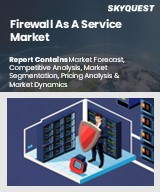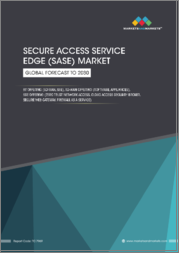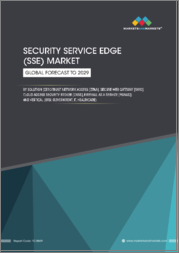
|
시장보고서
상품코드
1496098
세계의 FWaaS(Firewall as a Service) 시장 :현황 분석과 예측(2024-2032년)Firewall as a Service Market: Current Analysis and Forecast (2024-2032) |
||||||
FWaaS(Firewall as a Service) 시장은 네트워크 보안과 프라이버시에 대한 수요가 높아짐에 따라 CAGR 약 19.54%의 강력한 성장이 예상되고 있습니다. 또한 클라우드 컴퓨팅의 보급은 기업의 IT 인프라를 운영하고 관리하는 방법의 패러다임 변화를 가져오고 있습니다. FWaaS는 다양한 클라우드 플랫폼과의 원활한 통합을 제공하여 하이브리드 및 멀티클라우드 환경 전반에 걸쳐 일관된 보안 정책을 보장합니다. 또한 COVID-19의 유행은 원격 근무의 도입을 가속화하고 있습니다. 직원이 여러 장치 및 위치에서 기업 리소스에 액세스하기 때문에 기존의 온프레미스 방화벽은 종합적인 보호를 제공하기 위해 어려움을 겪고 있습니다. FWaaS는 위치나 장치에 관계없이 일관된 정책을 적용하고 원격 근무자를 보호할 수 있는 중앙 집중식 보안 솔루션을 제공합니다. 또한, 급속히 진화하는 오늘날의 비즈니스 환경에서 기업은 민첩성과 운영을 신속하게 확장할 수 있는 능력이 필요합니다. FWaaS 솔루션은 온디맨드 확장성을 제공하므로 기업은 요구 사항의 변화에 따라 보안 리소스를 쉽게 조정할 수 있습니다. 게다가 사이버 보안 산업은 숙련된 전문가의 상당한 부족에 직면하고 있으며, 기업이 사내에 보안 팀을 구축하고 유지하는 것은 어렵습니다. 예를 들어,(ISC)2 Cybersecurity Workforce Study 2022에 따르면 세계 사이버 보안 인력의 격차는 2021년 270만 명에서 340만 명으로 증가하고 있습니다. 이러한 동향은 다양한 산업에서 FWaaS(Firewall as a Service)를 널리 채용하는 데 영향을 주며 환경을 조장하고 있습니다.
시장은 서비스 유형별로 트래픽 모니터링, 제어, 컴플라이언스 및 감사 관리, 보고 및 로그 관리, 자동화 및 오케스트레이션, 보안 관리, 관리 서비스, 전문 서비스 등으로 구분됩니다. 벤더 수익의 대부분을 차지하는 것은 트래픽 모니터링 및 제어 분야입니다. 주로 모든 유형의 보안 침해를 제한할 필요성이 가속화되고 있습니다. 트래픽 모니터링 및 제어는 네트워크 트래픽을 지속적으로 모니터링하고 의심스러운 활동과 악의적인 활동을 모니터링함으로써 보안 침해를 방지하는 매우 중요한 역할을합니다. 이 능동적 인 접근법은 기밀 데이터를 보호하고 사이버 위협을 방지하는 데 매우 중요합니다. 또한, 이 부문은 네트워크 동작에 대한 실시간 통찰력을 제공하므로 비정상 및 잠재적인 위협에 즉각적으로 대응할 수 있습니다. 트래픽 패턴을 분석함으로써 기업은 보안 문제를 신속하게 감지하고 해결할 수 있습니다. 또한 트래픽 모니터링 및 제어는 침입 탐지 시스템 및 방화벽과 같은 다른 보안 조치와 원활하게 통합되어 다양한 사이버 위협에 대한 종합적인 보호 기능을 제공합니다. 이러한 일관된 접근 방식은 전체 네트워크 보안을 강화하기 때문에 다양한 산업 분야에서 FWaaS(Firewall as a Service)의 요구가 더욱 커지고 있습니다.
서비스 모델에 따라 시장은 IaaS(infrastructure as a service), PaaS(platform as a service), SaaS(software as a service)로 구분됩니다. SaaS는 가장 큰 시장 점유율을 차지하며 수요가 높은 부문입니다. SaaS가 널리 채택된 주요 요인은 이 서비스가 제공하는 접근성과 편리함입니다. SaaS는 로컬로 설치하거나 유지할 필요가 없으며 인터넷을 통해 직접 소프트웨어 용도에 액세스할 수 있는 기능을 사용자에게 제공합니다. 이 편의성은 모든 규모의 기업에게 매우 매력적입니다. 게다가 SaaS를 활용함으로써 기업들은 고가의 인프라와 소프트웨어 개발에 투자할 필요가 없습니다. 일반적으로 사용자는 구독 요금을 지불하므로 IT 비용 절감을 목표로 하는 기업에게는 비용 효율적인 옵션이 됩니다. 또한 SaaS 용도는 인터넷에서 바로 사용할 수 있으므로 신속한 배포 및 배포가 가능하며 신규 프로젝트 시장 출시 시간을 대폭 단축할 수 있습니다. 이러한 요인이 좋은 환경을 만들어 시장에서 SaaS 수요에 영향을 미치고 있습니다.
도입 형태에 따라 시장은 퍼블릭 클라우드, 프라이빗 클라우드, 하이브리드 클라우드로 구분됩니다. 퍼블릭 클라우드는 시장 점유율의 대부분을 차지하며 수요가 높습니다. 퍼블릭 클라우드의 FWaaS 솔루션은 종량 과금제를 채택하여 비용 효율적인 경우가 많습니다. 기업은 필요에 따라 방화벽 리소스를 확장할 수 있으므로 기존 방화벽과 관련된 하드웨어의 초기 비용과 유지 관리 비용을 피할 수 있습니다. 또한 퍼블릭 클라우드 제공업체는 탁월한 확장성과 유연성을 제공하므로 기업은 변화하는 비즈니스 요구와 워크로드 수요에 신속하게 대응할 수 있습니다. 이 확장성은 FWaaS 솔루션에 특히 유용하며 기업은 진화하는 보안 요구 사항에 따라 방화벽 리소스를 쉽게 늘리거나 줄일 수 있습니다. 또한 퍼블릭 클라우드 제공업체는 여러 데이터센터와 가용 영역을 갖춘 세계적인 존재감을 보여주므로 기업은 다양한 지역에 FWaaS 솔루션을 배포하고 고가용성과 재해 복구를 목적으로 한 내장 중복성을 활용할 수 있습니다. 이러한 발전은 다양한 업계에서 방화벽을 구축하는 퍼블릭 클라우드의 채택 확대에 기여하고 있습니다.
최종 사용자별로 보면 시장은 IT 및 통신, 은행/금융서비스/보험(BFSI), 학술회, 정부·공공기관, 헬스케어·과학, 제조, 소매 및 E-Commerce, 에너지·유틸리티으로 구분됩니다. 은행 및 금융서비스·보험(BFSI) 부문은 세계 시장에서 FWaaS(Firewall as a Service)의 주요 최종 사용자입니다. BFSI 산업은 민감한 금융 데이터와 거래를 보호하기 위한 엄격한 규정과 규정 준수 요건에 노출되어 있습니다. 방화벽은 이러한 규제 기준을 충족하는 데 중요한 역할을 합니다. 게다가 금융기관은 엄청난 양의 기밀 데이터와 금전 거래를 다루기 때문에 사이버 범죄자에게 매력적인 표적이 되고 있습니다. 네트워크 방화벽은 다양한 사이버 위협에 대한 방어의 첫 번째 역할을 합니다. 게다가 BFSI 부문은 중요한 인프라로 간주되며, 혼란이나 위반이 있다면 경제와 사회적 신용에 심각한 영향을 미칠 수 있습니다. 네트워크 방화벽은 네트워크 트래픽을 제어하고 모니터링하여 이 중요한 인프라를 보호하는 데 도움이 됩니다. 또한 BFSI 업계는 온라인 뱅킹, 모바일 애플리케이션, 클라우드 기반 서비스 채택 등 급속한 디지털 변화가 진행되고 있습니다. 이러한 디지털 채널이 확대됨에 따라 공격 대상도 증가하기 때문에 강력한 네트워크 보안이 필요합니다. 이러한 요인으로 인해 BFSI 업계는 전 세계 FWaaS(Firewall as a Service)의 주요 최종 사용자가 되었습니다.
FWaaS(Firewall as a Service) 시장 도입에 대한 이해를 높이기 위해 시장은 북미(미국, 캐나다, 기타 북미), 유럽(독일, 영국, 프랑스, 이탈리아, 기타 유럽), 아시아태평양(중국, 일본, 인도, 한국, 기타 아시아태평양), 세계 기타 지역에서 세계의 존재를 기반으로 분석됩니다. FWaaS(Firewall as a Service)는 디지털 자산과 기밀 정보를 사이버 위협으로부터 보호하는 데 중요한 역할을 합니다. 북미는 FWaaS(Firewall as a Service)의 최대 시장으로 부상하고 있습니다. 이 이점은 기술의 진보로 인한 것입니다. 북미, 특히 미국은 기술 혁신과 최첨단 사이버 보안 솔루션의 기반입니다. 또한 북미는 견조한 경제를 자랑하며 다양한 업종의 대기업과 기업이 많이 존재합니다. 이러한 조직은 위험을 효과적으로 줄이기 위해 네트워크 보안 방화벽에 투자하는 등 사이버 보안을 위해 많은 IT 예산을 할당합니다. 또한 세계 최대의 디지털 인구를 보유한 미국에서는 매년 상당수의 사이버 공격이 목격되고 있습니다. 2021년에 실시된 조사에 따르면, 이 나라의 온라인 사용자의 약 60%가 어떠한 사이버 공격에 직면하고 있으며, 사이버 범죄의 만연이라는 점에서 세 번째로 높은 나라가 되고 있습니다. 최근 보고서에서는 미국에서 약 2억 9,400만 명의 인터넷 사용자가 데이터 침해 피해를 입고 있습니다. 다양한 유형의 사이버 공격 중에서도 네트워크 침입은 미국에서 가장 많이 발생하고 있으며, 정부가 사이버 보안 전략에 대한 투자를 늘리는 동기 부여가 되어 FWaaS(Firewall as a Service) 벤더에게 이익을 가져오고 있습니다. 예를 들어, 2024년도에는 DHS가 사이버 보안에 30억 달러 이상을 할당하고, DoD를 제외한 CFO 행위 정부기관 중 최고 자금제공기관이 되었습니다.미국 전체 사이버 보안 지출은 2023년에 증가했으며 정부 기관의 총 자금은 104억 6,000만 달러로 추정됩니다.
시장에 진입하는 주요 기업으로는 Sinch, AMD Telecom, Orange, SAP, Sophos Ltd., Tata Communications, Telecom Italia Sparkle SpA, Twilio Inc., Route Mobile, Nokia 등이 있습니다.
목차
제1장 시장 소개
- 시장 정의
- 주요 목표
- 이해관계자
- 제한 사항
제2장 조사 방법 또는 전제조건
- 조사 과정
- 조사 방법
- 응답자 프로파일
제3장 시장 요약
제4장 주요 요약
제5장 COVID-19가 FWaaS(Firewall as a Service) 시장에 미치는 영향
제6장 FWaaS(Firewall as a Service) 시장 수익(2022-2032년)
제7장 시장 인사이트: 서비스 유형별
- 트래픽 모니터링 및 제어
- 컴플라이언스 및 감사 관리
- 보고서 및 로그 관리
- 자동화 및 오케스트레이션
- 보안관리
- 매니지드 서비스
- 전문 서비스
- 기타(접속·구성 관리)
제8장 시장 인사이트: 서비스 모델별
- IaaS(Infrastructure as a Service)
- PaaS(Platform as a Service)
- SaaS(Software as a Service)
제9장 시장 인사이트: 전개별
- 퍼블릭 클라우드
- 프라이빗 클라우드
- 하이브리드 클라우드
제10장 시장 인사이트: 최종 사용자별
- IT 및 통신
- BFSI
- 학술계
- 정부 및 공공 부문
- 헬스케어 및 과학
- 제조업
- 소매업 및 E-Commerce
- 에너지 및 유틸리티
제11장 시장 인사이트: 지역별
- 북미
- 미국
- 캐나다
- 기타 북미
- 유럽
- 독일
- 영국
- 프랑스
- 이탈리아
- 기타 유럽
- 아시아태평양
- 중국
- 인도
- 일본
- 한국
- 기타 아시아태평양
- 세계 기타 지역
제12장 FWaaS(Firewall as a Service) 시장 역학
- 시장 성장 촉진요인
- 시장의 과제
- 영향 분석
제13장 FWaaS(Firewall as a Service) 시장 기회
제14장 FWaaS(Firewall as a Service) 시장 동향
제15장 수요측과 공급측 분석
- 수요측 분석
- 공급측 분석
제16장 밸류체인 분석
제17장 경쟁 시나리오
- 경쟁 구도
- Porter's Five Forces 분석
제18장 기업 프로파일
- Sinch
- AMD Telecom
- Orange
- SAP
- Sophos Ltd.
- Tata Communications
- Telecom Italia Sparkle SpA
- Twilio Inc.
- Route Mobile
- Nokia
제19장 면책사항
JHS 24.06.25Firewall as a Service (FWaaS) is a cloud-based firewall solution that helps simplify IT infrastructure for companies. It provides next-generation firewall capabilities like web filtering, advanced threat protection, intrusion prevention systems, and Domain Name System security. Essentially, FWaaS delivers firewall protection through a cloud-based service model, offering companies the benefits of security without the need for physical hardware on-site. This service is designed to enhance network security by monitoring and controlling incoming and outgoing data traffic based on established security rules, helping to prevent unauthorized access and protect against potential threats.
The Firewall as a Service Market is expected to grow at a strong CAGR of around 19.54% owing to the increased demand for network security and privacy. Furthermore, the proliferation of cloud computing has led to a paradigm shift in how businesses operate and manage their IT infrastructure. FWaaS provides seamless integration with various cloud platforms, ensuring consistent security policies across hybrid and multi-cloud environments. Moreover, the COVID-19 pandemic has accelerated the adoption of remote work. With employees accessing corporate resources from multiple devices and locations, traditional on-premises firewalls struggle to provide comprehensive protection. FWaaS offers a centralized security solution that can enforce consistent policies and protect remote workers, regardless of their location or device. Additionally, in today's rapidly evolving business landscape, organizations require agility and the ability to scale their operations quickly. FWaaS solutions offer on-demand scalability, allowing businesses to easily adjust their security resources based on changing requirements. Furthermore, the cybersecurity industry is facing a significant shortage of skilled professionals, making it challenging for organizations to build and maintain in-house security teams. For instance, according to the (ISC)2 Cybersecurity Workforce Study 2022, the global cybersecurity workforce gap has increased to 3.4 million, up from 2.7 million in 2021. These developments along with others are fostering a conducive environment, influencing the widespread adoption of firewalls as a service across various industries.
Based on the service type, the market is segmented into traffic monitoring and control, compliance and audit management, reporting and Log management, automation and orchestration, security management, managed services, professional services, and others. The traffic monitoring and control segment generates the majority portion of revenue for the firewall as a service vendor. Primarily driven by the need to restrict any sort of security breaches. Traffic monitoring and control play a pivotal role in preventing security breaches by continuously monitoring network traffic for any suspicious or unauthorized activities. This proactive approach is crucial in safeguarding sensitive data and preventing cyber threats. Furthermore, this segment provides real-time insights into network behavior, allowing immediate responses to any anomalies or potential threats. By analyzing traffic patterns, organizations can detect and address security issues promptly. Additionally, traffic monitoring and control seamlessly integrate with other security measures, such as intrusion detection systems and firewalls, to provide comprehensive protection against diverse cyber threats. This cohesive approach enhances overall network security, further fueling the need for firewalls as a service across various industries.
Based on the service model, the market is segmented into infrastructure as a service (IaaS), platform as a service (PaaS), and software as a service (SaaS). SaaS is the segment that commands the largest market share and is in high demand. The primary factor contributing to this widespread adoption includes the accessibility and convenience that this service provides. SaaS offers users the ability to access software applications directly through the internet without needing to install or maintain them locally. This convenience makes it highly attractive to businesses of all sizes. Furthermore, SaaS eliminates the need for companies to invest in expensive infrastructure or software development. Users typically pay a subscription fee, making it a cost-effective option for organizations looking to reduce IT expenses. Additionally, SaaS applications are readily available over the internet, allowing for quick deployment and implementation, significantly reducing time-to-market for new projects. Factors such as these are creating a favorable environment, influencing the demand for SaaS in the markets.
Based on deployment, the market is segmented into public cloud, private cloud, and hybrid cloud. The public cloud segment holds the majority of the market share and is highly in demand. Public cloud FWaaS solutions are often more cost-effective as they follow a pay-as-you-go pricing model. Organizations can scale their firewall resources based on needs, avoiding upfront hardware costs and maintenance expenses associated with traditional firewalls. Furthermore, public cloud providers offer unparalleled scalability and flexibility, allowing organizations to quickly adapt to changing business needs and workload demands. This scalability is particularly beneficial for FWaaS solutions, as it enables organizations to easily scale their firewall resources up or down based on their evolving security requirements. Moreover, public cloud providers have a global presence with multiple data centers and availability zones, enabling organizations to deploy FWaaS solutions across different regions and leverage built-in redundancy for high availability and disaster recovery purposes. These developments along with others have contributed to the growth in the adoption of public cloud for the deployment of firewalls across various industries.
Based on end-users, the market is segmented into IT & telecommunication, BFSI, Academia, government and public sectors, healthcare and science, manufacturing, retail and e-commerce, and energy and utilities. The Banking, Financial Services, and Insurance (BFSI) sector is the major end-user for firewalls as a service in the global market. The BFSI industry is subject to strict regulations and compliance requirements to safeguard sensitive financial data and transactions. Firewalls play a crucial role in meeting these regulatory standards. Furthermore, financial institutions handle vast amounts of sensitive data and monetary transactions, making them attractive targets for cybercriminals. Network firewalls act as the first line of defense against various cyber threats. Moreover, The BFSI sector is considered critical infrastructure, and any disruption or breach can have severe consequences for the economy and public trust. Network firewalls help protect this critical infrastructure by controlling and monitoring network traffic. Additionally, the BFSI industry is undergoing rapid digital transformation, with the adoption of online banking, mobile applications, and cloud-based services. As these digital channels expand, the attack surface also increases, necessitating robust network security. Factors such as these have made the BFSI industry a major end-user segment for firewalls as a service across the world.
For a better understanding of the market adoption of Firewall as a service, the market is analyzed based on its worldwide presence in countries such as North America (The U.S., Canada, and the Rest of North America), Europe (Germany, The U.K., France, Italy, Rest of Europe), Asia-Pacific (China, Japan, India, South Korea, Rest of Asia-Pacific), Rest of World. Firewalls as a service play a crucial role in safeguarding digital assets and sensitive information from cyber threats. North America emerges as the largest market for firewalls as a service. This dominance can be attributed to technological advancement. North America, particularly the United States, is a hub for technological innovation and cutting-edge cybersecurity solutions. Furthermore, North America boasts a robust economy with a significant number of large enterprises and businesses across various industries. These organizations have substantial IT budgets allocated for cybersecurity, including investment in network security firewalls to mitigate risks effectively. Moreover, the United States, with one of the largest digital populations globally, witnesses a significant number of cyber attacks annually. As per a survey conducted in 2021, approximately 60 percent of online users in the country encountered some form of cyber attack, placing it as the third-highest country in terms of cybercrime prevalence. In the latest reported year, incidents of data violation affected approximately 294 million internet users in the United States. Among the various types of cyber attacks, network intrusion emerged as the most prevalent across the nation, motivating the government to increase investments in cyber security strategy, benefiting the firewall as a service vendor. For instance, In FY 2024, DHS allocated over USD 3 billion to cybersecurity, making it the top-funded agency among CFO act government agencies, excluding DoD. Overall cybersecurity expenditure in the US was increased in 2023, with total agency funding estimated at USD 10.46 billion.
Some of the major players operating in the market include Sinch; AMD Telecom; Orange; SAP; Sophos Ltd.; Tata Communications; Telecom Italia Sparkle S.p.A; Twilio Inc.; Route Mobile; and Nokia.
TABLE OF CONTENTS
1.MARKET INTRODUCTION
- 1.1. Market Definitions
- 1.2. Main Objective
- 1.3. Stakeholders
- 1.4. Limitation
2.RESEARCH METHODOLOGY OR ASSUMPTION
- 2.1. Research Process of the Firewall as a Service Market
- 2.2. Research Methodology of the Firewall as a Service Market
- 2.3. Respondent Profile
3.MARKET SYNOPSIS
4.EXECUTIVE SUMMARY
5.IMPACT OF COVID-19 ON THE FIREWALL AS A SERVICE MARKET
6.FIREWALL AS A SERVICE MARKET REVENUE (USD BN), 2022-2032F.
7.MARKET INSIGHTS BY SERVICE TYPE
- 7.1. Traffic Monitoring and Control
- 7.2. Compliance and Audit Management
- 7.3. Reporting and Log Management
- 7.4. Automation and Orchestration
- 7.5. Security Management
- 7.6. Managed Services
- 7.7. Professional Services
- 7.8. Others (Connectivity and Configuration Management)
8.MARKET INSIGHTS BY SERVICE MODEL
- 8.1. Infrastructure as a Service (IaaS)
- 8.2. Platform as a Service (PaaS)
- 8.3. Software as a Service (SaaS)
9.MARKET INSIGHTS BY DEPLOYMENT
- 9.1. Public Cloud
- 9.2. Private Cloud
- 9.3. Hybrid Cloud
10.MARKET INSIGHTS BY END-USER
- 10.1. IT & Telecommunication
- 10.2. BFSI
- 10.3. Academia
- 10.4. Government and Public Sector
- 10.5. Healthcare and Science
- 10.6. Manufacturing
- 10.7. Retail and E-Commerce
- 10.8. Energy and Utilities
11.MARKET INSIGHTS BY REGION
- 11.1. North America
- 11.1.1. The U.S.
- 11.1.2. Canada
- 11.1.3. Rest of North America
- 11.2. Europe
- 11.2.1. Germany
- 11.2.2. The UK
- 11.2.3. France
- 11.2.4. Italy
- 11.2.5. Rest of Europe
- 11.3. Asia-Pacific
- 11.3.1. China
- 11.3.2. India
- 11.3.3. Japan
- 11.3.4. South Korea
- 11.3.5. Rest of Asia-Pacific
- 11.4. Rest of the World
12.FIREWALL AS A SERVICE MARKET DYNAMICS
- 12.1. Market Drivers
- 12.2. Market Challenges
- 12.3. Impact Analysis
13.FIREWALL AS A SERVICE MARKET OPPORTUNITIES
14.FIREWALL AS A SERVICE MARKET TRENDS
15.DEMAND AND SUPPLY-SIDE ANALYSIS
- 15.1. Demand Side Analysis
- 15.2. Supply Side Analysis
16.VALUE CHAIN ANALYSIS
17.COMPETITIVE SCENARIO
- 17.1. Competitive Landscape
- 17.1.1. Porters Five Forces Analysis
18.COMPANY PROFILED
- 18.1. Sinch
- 18.2. AMD Telecom
- 18.3. Orange
- 18.4. SAP
- 18.5. Sophos Ltd.
- 18.6. Tata Communications
- 18.7. Telecom Italia Sparkle S.p.A
- 18.8. Twilio Inc.
- 18.9. Route Mobile
- 18.10. Nokia



















